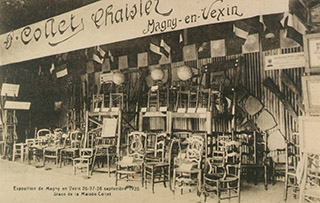Prochain point : lat="49.1575" lon="1.78589"

Chair Making in Magny
A very important business
A thriving industry for the town...
Magny-en-Vexin has always been a city of merchants and artisans, and was once home to a collection of carpenters, cabinet makers, clog makers and turners. Chair making, which had its roots in the woodworking tradition, developed in the mid-nineteenth century. There were five chairs makers in 1861, with unbroken growth between 1860 and 1880. Many women worked from home as straw workers or making chairs. When the industry reached its peak in 1876, 212 people were employed in eleven factories, producing about 6,000 dozen chairs a year. After thirty years or so of prosperity, the decline began in 1881, largely due to competition from the prisons at Gaillon and Poissy, where the wages were well below those in Magny-en-Vexin (1.75 francs compared to five or six francs). There were only three manufacturers left in 1911.
... The Couturier family: a cutting-edge business
The Couturiers played a leading role in the chair-making industry. Hilaire Clément Couturier set up his turning shop in Rue Villeroy in 1839, converting it into a chair maker’s and employing his son Prosper and two fellow workers. After the business gained momentum, it moved to Rue de la Plaine, where the wood arrived in the form of logs before being sawn, processed and assembled.
Prosper filed a patent for a tongue and groove chair design in 1874. He also won a prize at the 1878 Universal Exhibition for his method of bending cylindrical timber with steam. Around 90 models of chair were on sale in 1909 in a range of different woods (beech, ash, walnut), seat upholstery (straw, quilting, cane), shapes, colours, ornamentation (with lyre, comber board or strip backs) and uses (bar and office chairs, kneelers, etc.). Three successive generations served at the head of the company before it was sold in 1920.





